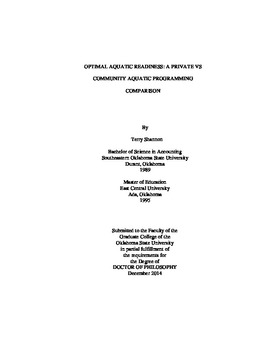| dc.contributor.advisor | Caneday, Lowell | |
| dc.contributor.author | Shannon, Terry Vernon | |
| dc.date.accessioned | 2015-06-17T20:07:59Z | |
| dc.date.available | 2015-06-17T20:07:59Z | |
| dc.date.issued | 2014-12 | |
| dc.identifier.uri | https://hdl.handle.net/11244/15117 | |
| dc.description.abstract | The purpose of this study was to investigate if instructors in a private aquatic training program score students' optimal readiness differently than those in a community non-profit aquatic training program based on the instructors scoring. In this study, the Aquatic Readiness Assessment was utilized for determining optimal readiness for advancement in aquatic education which potentially may lead to a safer aquatic experience. This comparison was to determine if instructors from a private aquatic training program with the Water Safety Instructor training can advance students to the point of optimal readiness to achieve aquatic skills more quickly than instructors from a community non-profit aquatic training program. This study was guided by the following research question: do aquatic instructors employed at a private aquatic facility score learner readiness differently than instructors employed at a community non-profit facility over a 3-week swim class? There were one hundred twenty students (n=120) scored by the ten instructors, five at each facility, using the ARA. The students were divided into two groups, according to the aquatic training center they attend for lessons (private vs. community). Sixty students from each aquatic training center were assessed using the ARA. Instructors scored the first sixty students in each facility which were tested and scored below twenty-seven on the ARA, which assigned them to the stage one aquatic training program. This assured that all students began at the same aquatic skill level. A pretest and posttest, three weeks between tests, was scored by five instructors on each of the sixty students within their facility. A cross-tabulation and chi-square statistic was utilized to examine and compare the advancing number of students between the private and community non-profit aquatic training program. The private advanced thirty-eight students, while the community non-profit advanced forty-seven. The chi-square analysis indicated there was not a significant difference in the pass rate between the private facility vs. community non-profit facility at p<=.05 with a result of p=.071. A Mann-Whitney U non-parametric analysis was utilized to determine the mean score change between the facilities. The analysis showed the instructors in the private facility scored a change of 6.82. A Wilcoxon T non-parametric analysis was utilized to determine the difference between the instructors within each facility. The analysis showed the instructor change in the community non-profit to be 7.13. The results did not show a significant difference in scores among advancing students to level two aquatic training. However, the results did demonstrate an improvement among the students at both facilities and showed the value of aquatic training. | |
| dc.format | application/pdf | |
| dc.language | en_US | |
| dc.rights | Copyright is held by the author who has granted the Oklahoma State University Library the non-exclusive right to share this material in its institutional repository. Contact Digital Library Services at lib-dls@okstate.edu or 405-744-9161 for the permission policy on the use, reproduction or distribution of this material. | |
| dc.title | Optimal aquatic readiness: A private vs community aquatic programming comparison | |
| dc.contributor.committeeMember | Ausburn, Lynna J. | |
| dc.contributor.committeeMember | Lindenmeier, Donna | |
| dc.contributor.committeeMember | Tapps, Tyler Nicholas | |
| osu.filename | Shannon_okstate_0664D_13675.pdf | |
| osu.accesstype | Open Access | |
| dc.type.genre | Dissertation | |
| dc.type.material | Text | |
| dc.subject.keywords | aquatic | |
| dc.subject.keywords | optimal | |
| dc.subject.keywords | readiness | |
| thesis.degree.discipline | Leisure Studies | |
| thesis.degree.grantor | Oklahoma State University | |
